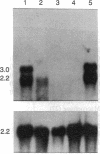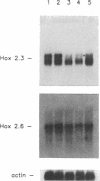Abstract
We investigated the role of homeobox-containing genes in human hematopoiesis because homeobox genes (i) control cell fate in the Drosophila embryo, (ii) are expressed in specific patterns in human embryos, and (iii) appear to function as transcription factors that control cell phenotype in other mammalian organs. Using four homeobox probes from the HOX2 locus and a previously undescribed homeobox cDNA (PL1), we screened mRNAs from 18 human leukemic cell lines representing erythroid, myeloid, and T- and B-cell lineages. Complex patterns of lineage-restricted expression are observed: some are restricted to a single lineage, while others are expressed in multiple lineages. No single homeobox gene is expressed in all types of hematopoietic cells, but each cell type exhibits homeobox gene expression. HOX2.2 and -2.3 homeobox-containing cDNAs were cloned from an erythroleukemia cell (HEL) cDNA library, while the homeobox cDNA PL1 was isolated from a monocytic cell (U-937) library. Differentiation of HEL and K-562 cells with various inducers results in modulation of specific homeobox transcripts. In addition, HOX2.2 is expressed in normal bone marrow cells. We have demonstrated (i) lineage-restricted expression of five homeobox genes in erythroid and monocytic cell lines; (ii) expression of additional homeobox genes in other cell lineages (HL-60 and lymphoid cells); (iii) expression of one homeobox gene in normal marrow cells; and (iv) modulation of expression during differentiation. These data suggest that these genes play a role in human hematopoietic development and lineage commitment.
Full text
PDF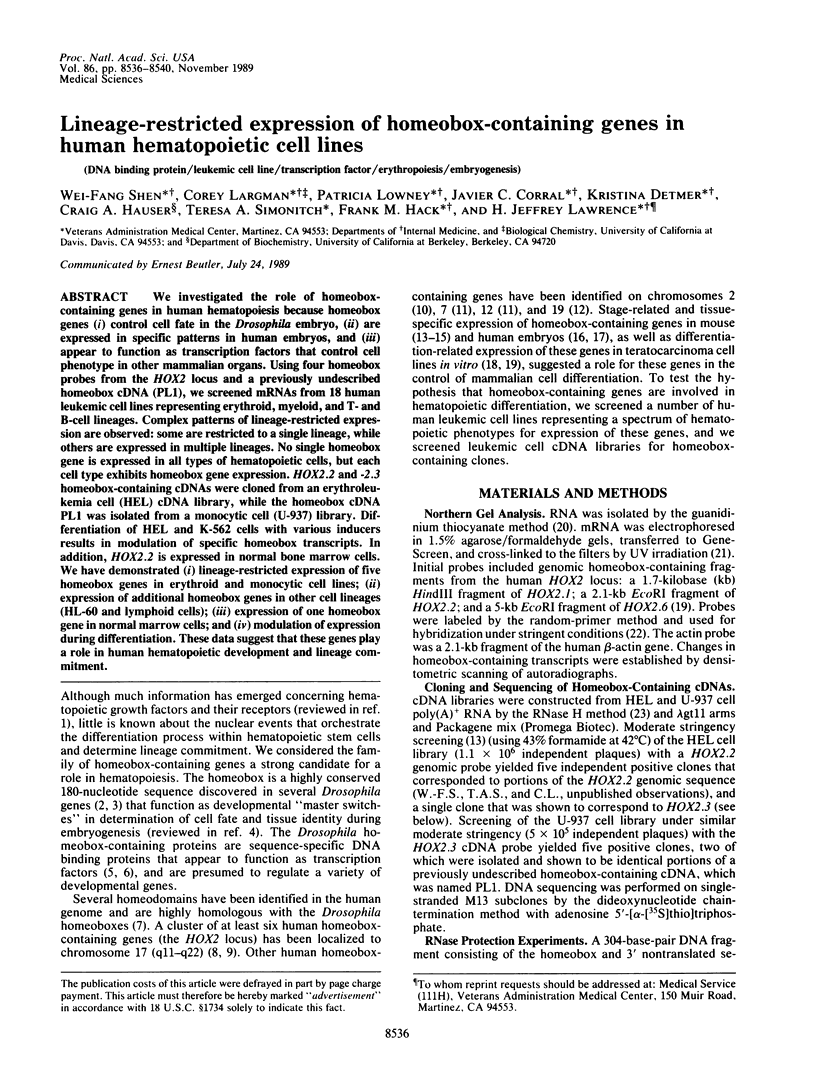
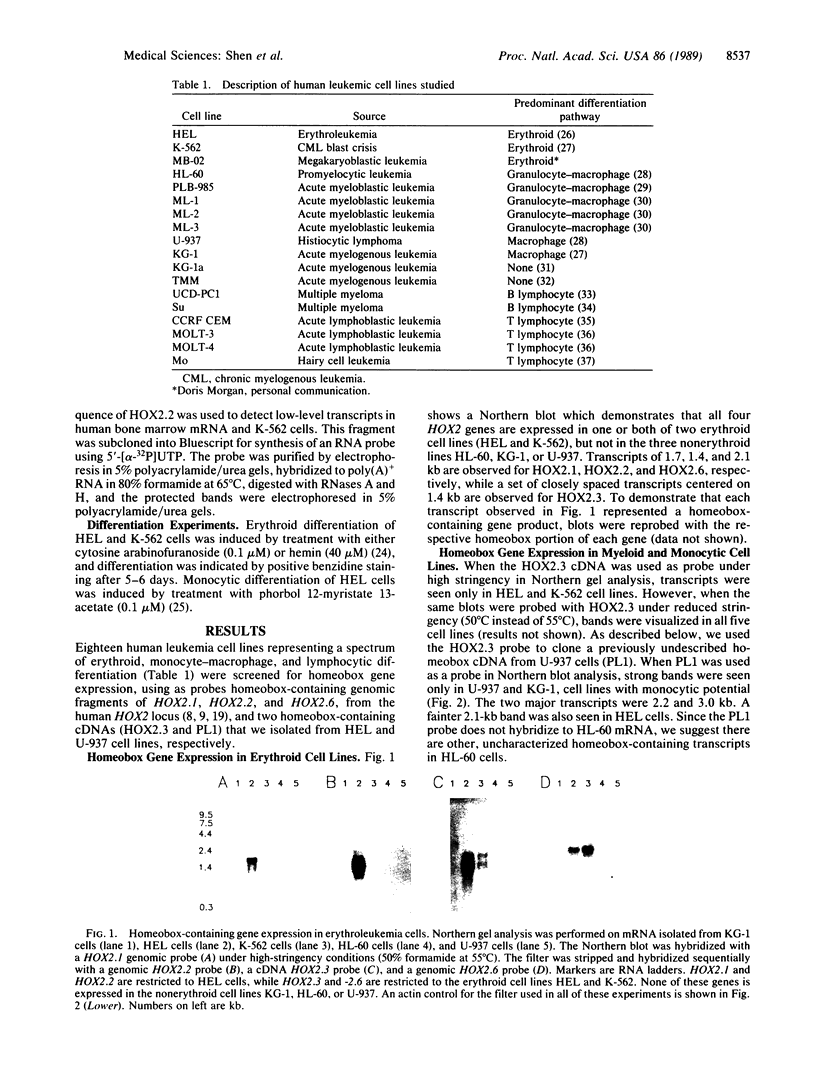
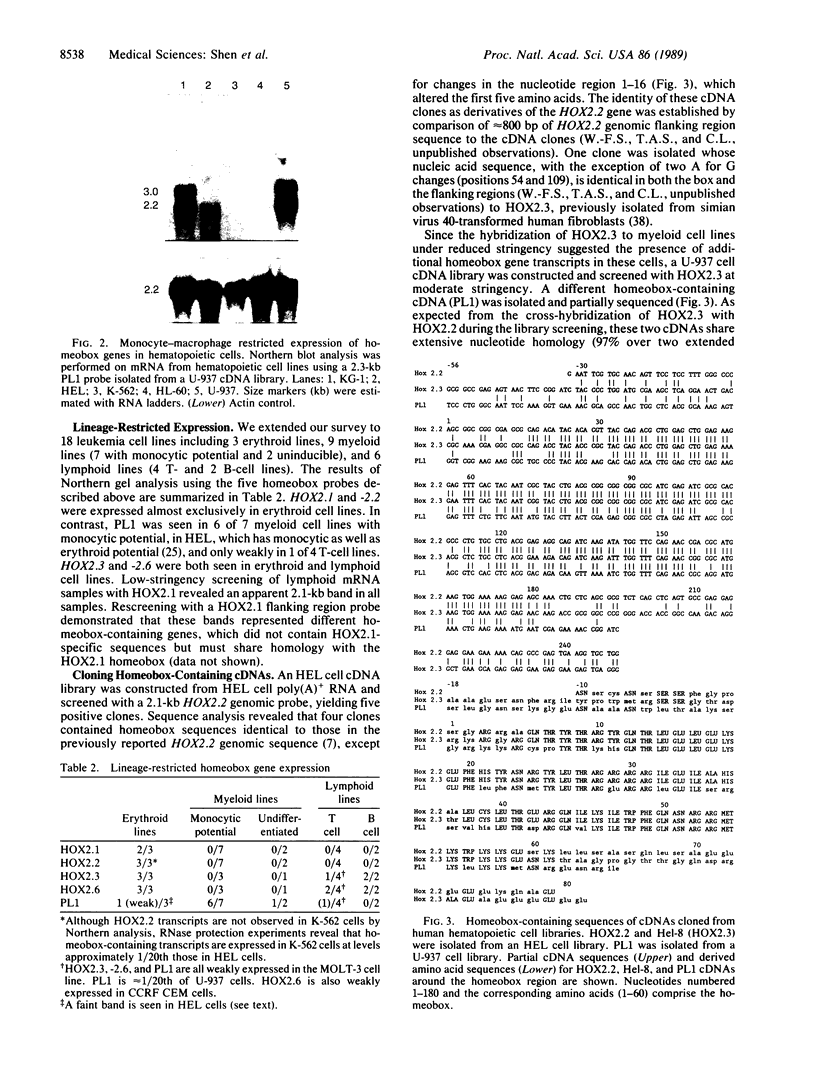
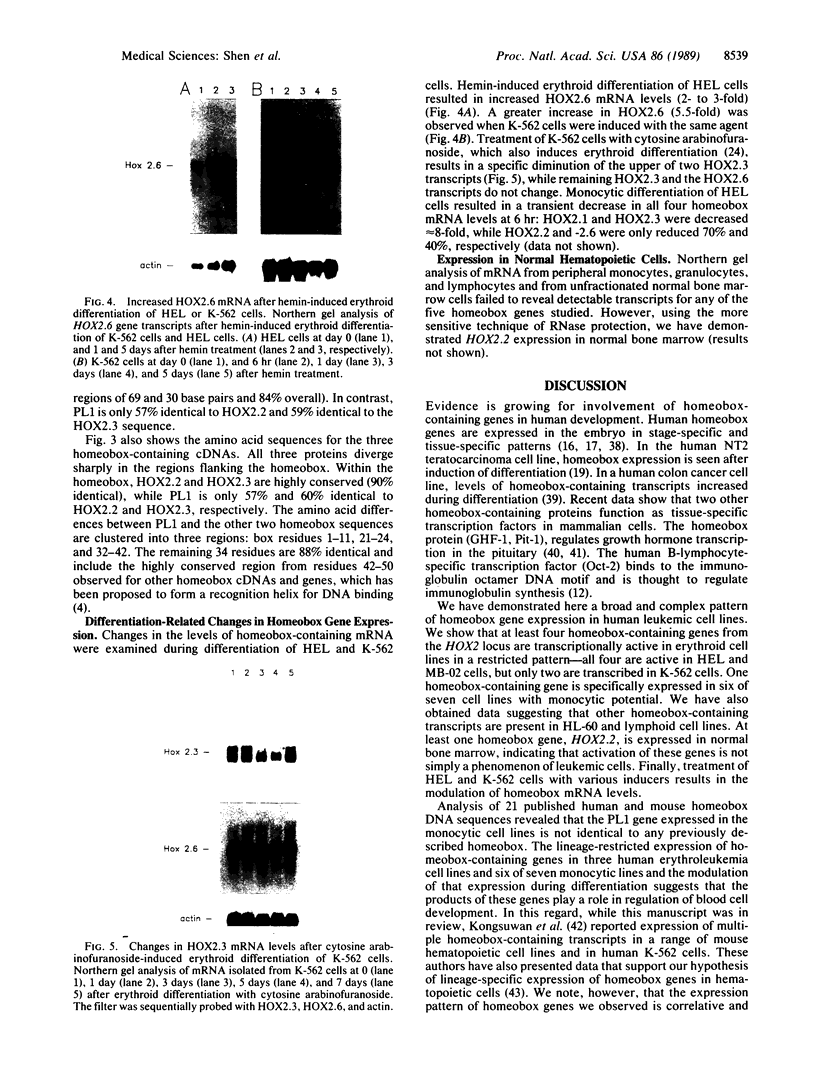
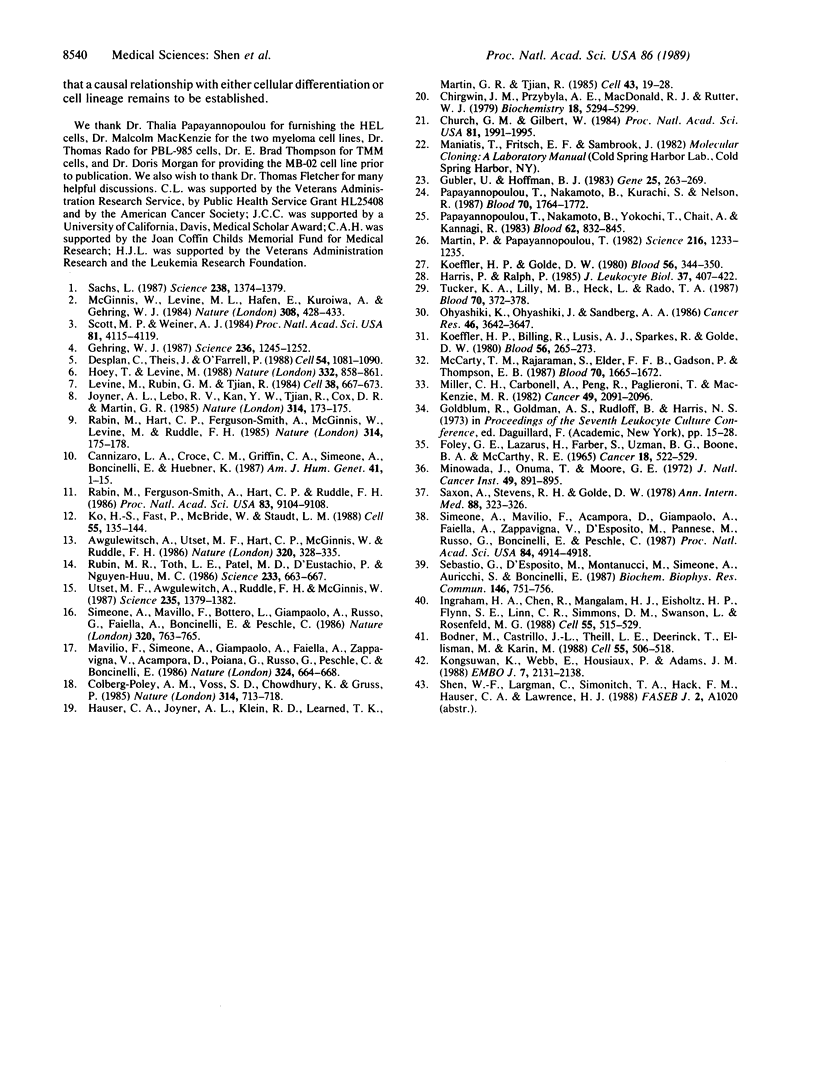
Images in this article
Selected References
These references are in PubMed. This may not be the complete list of references from this article.
- Awgulewitsch A., Utset M. F., Hart C. P., McGinnis W., Ruddle F. H. Spatial restriction in expression of a mouse homoeo box locus within the central nervous system. 1986 Mar 27-Apr 2Nature. 320(6060):328–335. doi: 10.1038/320328a0. [DOI] [PubMed] [Google Scholar]
- Bodner M., Castrillo J. L., Theill L. E., Deerinck T., Ellisman M., Karin M. The pituitary-specific transcription factor GHF-1 is a homeobox-containing protein. Cell. 1988 Nov 4;55(3):505–518. doi: 10.1016/0092-8674(88)90037-2. [DOI] [PubMed] [Google Scholar]
- Cannizzaro L. A., Croce C. M., Griffin C. A., Simeone A., Boncinelli E., Huebner K. Human homeo box-containing genes located at chromosome regions 2q31----2q37 and 12q12----12q13. Am J Hum Genet. 1987 Jul;41(1):1–15. [PMC free article] [PubMed] [Google Scholar]
- Chirgwin J. M., Przybyla A. E., MacDonald R. J., Rutter W. J. Isolation of biologically active ribonucleic acid from sources enriched in ribonuclease. Biochemistry. 1979 Nov 27;18(24):5294–5299. doi: 10.1021/bi00591a005. [DOI] [PubMed] [Google Scholar]
- Church G. M., Gilbert W. Genomic sequencing. Proc Natl Acad Sci U S A. 1984 Apr;81(7):1991–1995. doi: 10.1073/pnas.81.7.1991. [DOI] [PMC free article] [PubMed] [Google Scholar]
- Colberg-Poley A. M., Voss S. D., Chowdhury K., Gruss P. Structural analysis of murine genes containing homoeo box sequences and their expression in embryonal carcinoma cells. 1985 Apr 25-May 1Nature. 314(6013):713–718. doi: 10.1038/314713a0. [DOI] [PubMed] [Google Scholar]
- Desplan C., Theis J., O'Farrell P. H. The sequence specificity of homeodomain-DNA interaction. Cell. 1988 Sep 23;54(7):1081–1090. doi: 10.1016/0092-8674(88)90123-7. [DOI] [PMC free article] [PubMed] [Google Scholar]
- FOLEY G. E., LAZARUS H., FARBER S., UZMAN B. G., BOONE B. A., MCCARTHY R. E. CONTINUOUS CULTURE OF HUMAN LYMPHOBLASTS FROM PERIPHERAL BLOOD OF A CHILD WITH ACUTE LEUKEMIA. Cancer. 1965 Apr;18:522–529. doi: 10.1002/1097-0142(196504)18:4<522::aid-cncr2820180418>3.0.co;2-j. [DOI] [PubMed] [Google Scholar]
- Gehring W. J. Homeo boxes in the study of development. Science. 1987 Jun 5;236(4806):1245–1252. doi: 10.1126/science.2884726. [DOI] [PubMed] [Google Scholar]
- Gubler U., Hoffman B. J. A simple and very efficient method for generating cDNA libraries. Gene. 1983 Nov;25(2-3):263–269. doi: 10.1016/0378-1119(83)90230-5. [DOI] [PubMed] [Google Scholar]
- Harris P., Ralph P. Human leukemic models of myelomonocytic development: a review of the HL-60 and U937 cell lines. J Leukoc Biol. 1985 Apr;37(4):407–422. doi: 10.1002/jlb.37.4.407. [DOI] [PubMed] [Google Scholar]
- Hauser C. A., Joyner A. L., Klein R. D., Learned T. K., Martin G. R., Tjian R. Expression of homologous homeo-box-containing genes in differentiated human teratocarcinoma cells and mouse embryos. Cell. 1985 Nov;43(1):19–28. doi: 10.1016/0092-8674(85)90008-x. [DOI] [PubMed] [Google Scholar]
- Hoey T., Levine M. Divergent homeo box proteins recognize similar DNA sequences in Drosophila. Nature. 1988 Apr 28;332(6167):858–861. doi: 10.1038/332858a0. [DOI] [PubMed] [Google Scholar]
- Ingraham H. A., Chen R. P., Mangalam H. J., Elsholtz H. P., Flynn S. E., Lin C. R., Simmons D. M., Swanson L., Rosenfeld M. G. A tissue-specific transcription factor containing a homeodomain specifies a pituitary phenotype. Cell. 1988 Nov 4;55(3):519–529. doi: 10.1016/0092-8674(88)90038-4. [DOI] [PubMed] [Google Scholar]
- Joyner A. L., Lebo R. V., Kan Y. W., Tjian R., Cox D. R., Martin G. R. Comparative chromosome mapping of a conserved homoeo box region in mouse and human. Nature. 1985 Mar 14;314(6007):173–175. doi: 10.1038/314173a0. [DOI] [PubMed] [Google Scholar]
- Ko H. S., Fast P., McBride W., Staudt L. M. A human protein specific for the immunoglobulin octamer DNA motif contains a functional homeobox domain. Cell. 1988 Oct 7;55(1):135–144. doi: 10.1016/0092-8674(88)90016-5. [DOI] [PubMed] [Google Scholar]
- Koeffler H. P., Billing R., Lusis A. J., Sparkes R., Golde D. W. An undifferentiated variant derived from the human acute myelogenous leukemia cell line (KG-1). Blood. 1980 Aug;56(2):265–273. [PubMed] [Google Scholar]
- Koeffler H. P., Golde D. W. Human myeloid leukemia cell lines: a review. Blood. 1980 Sep;56(3):344–350. [PubMed] [Google Scholar]
- Kongsuwan K., Webb E., Housiaux P., Adams J. M. Expression of multiple homeobox genes within diverse mammalian haemopoietic lineages. EMBO J. 1988 Jul;7(7):2131–2138. doi: 10.1002/j.1460-2075.1988.tb03052.x. [DOI] [PMC free article] [PubMed] [Google Scholar]
- Levine M., Rubin G. M., Tjian R. Human DNA sequences homologous to a protein coding region conserved between homeotic genes of Drosophila. Cell. 1984 Oct;38(3):667–673. doi: 10.1016/0092-8674(84)90261-7. [DOI] [PubMed] [Google Scholar]
- Martin P., Papayannopoulou T. HEL cells: a new human erythroleukemia cell line with spontaneous and induced globin expression. Science. 1982 Jun 11;216(4551):1233–1235. doi: 10.1126/science.6177045. [DOI] [PubMed] [Google Scholar]
- Mavilio F., Simeone A., Giampaolo A., Faiella A., Zappavigna V., Acampora D., Poiana G., Russo G., Peschle C., Boncinelli E. Differential and stage-related expression in embryonic tissues of a new human homoeobox gene. Nature. 1986 Dec 18;324(6098):664–668. doi: 10.1038/324664a0. [DOI] [PubMed] [Google Scholar]
- McCarty T. M., Rajaraman S., Elder F. F., Gadson P., Thompson E. B. Establishment and characterization of a human myeloid cell line from Philadelphia chromosome-negative myeloblastic leukemia arising in a patient with myelodysplastic syndrome. Blood. 1987 Nov;70(5):1665–1672. [PubMed] [Google Scholar]
- McGinnis W., Levine M. S., Hafen E., Kuroiwa A., Gehring W. J. A conserved DNA sequence in homoeotic genes of the Drosophila Antennapedia and bithorax complexes. 1984 Mar 29-Apr 4Nature. 308(5958):428–433. doi: 10.1038/308428a0. [DOI] [PubMed] [Google Scholar]
- Miller C. H., Carbonell A., Peng R., Paglieroni T., MacKenzie M. R. A human plasma cell line: induction and characterization. Cancer. 1982 May 15;49(10):2091–2096. doi: 10.1002/1097-0142(19820515)49:10<2091::aid-cncr2820491021>3.0.co;2-9. [DOI] [PubMed] [Google Scholar]
- Minowada J., Onuma T., Moore G. E. Rosette-forming human lymphoid cell lines. I. Establishment and evidence for origin of thymus-derived lymphocytes. J Natl Cancer Inst. 1972 Sep;49(3):891–895. [PubMed] [Google Scholar]
- Ohyashiki K., Ohyashiki J. H., Sandberg A. A. Cytogenetic characterization of putative human myeloblastic leukemia cell lines (ML-1, -2, and -3): origin of the cells. Cancer Res. 1986 Jul;46(7):3642–3647. [PubMed] [Google Scholar]
- Papayannopoulou T., Nakamoto B., Kurachi S., Nelson R. Analysis of the erythroid phenotype of HEL cells: clonal variation and the effect of inducers. Blood. 1987 Dec;70(6):1764–1772. [PubMed] [Google Scholar]
- Papayannopoulou T., Nakamoto B., Yokochi T., Chait A., Kannagi R. Human erythroleukemia cell line (HEL) undergoes a drastic macrophage-like shift with TPA. Blood. 1983 Oct;62(4):832–845. [PubMed] [Google Scholar]
- Rabin M., Ferguson-Smith A., Hart C. P., Ruddle F. H. Cognate homeo-box loci mapped on homologous human and mouse chromosomes. Proc Natl Acad Sci U S A. 1986 Dec;83(23):9104–9108. doi: 10.1073/pnas.83.23.9104. [DOI] [PMC free article] [PubMed] [Google Scholar]
- Rabin M., Hart C. P., Ferguson-Smith A., McGinnis W., Levine M., Ruddle F. H. Two homoeo box loci mapped in evolutionarily related mouse and human chromosomes. Nature. 1985 Mar 14;314(6007):175–178. doi: 10.1038/314175a0. [DOI] [PubMed] [Google Scholar]
- Rubin M. R., Toth L. E., Patel M. D., D'Eustachio P., Nguyen-Huu M. C. A mouse homeo box gene is expressed in spermatocytes and embryos. Science. 1986 Aug 8;233(4764):663–667. doi: 10.1126/science.3726554. [DOI] [PubMed] [Google Scholar]
- Sachs L. The molecular control of blood cell development. Science. 1987 Dec 4;238(4832):1374–1379. doi: 10.1126/science.3317831. [DOI] [PubMed] [Google Scholar]
- Saxon A., Stevens R. H., Golde D. W. T-lymphocyte variant of hairy-cell leukemia. Ann Intern Med. 1978 Mar;88(3):323–326. doi: 10.7326/0003-4819-88-3-323. [DOI] [PubMed] [Google Scholar]
- Scott M. P., Weiner A. J. Structural relationships among genes that control development: sequence homology between the Antennapedia, Ultrabithorax, and fushi tarazu loci of Drosophila. Proc Natl Acad Sci U S A. 1984 Jul;81(13):4115–4119. doi: 10.1073/pnas.81.13.4115. [DOI] [PMC free article] [PubMed] [Google Scholar]
- Sebastio G., D'Esposito M., Montanucci M., Simeone A., Auricchio S., Boncinelli E. Modulated expression of human homeobox genes in differentiating intestinal cells. Biochem Biophys Res Commun. 1987 Jul 31;146(2):751–756. doi: 10.1016/0006-291x(87)90593-6. [DOI] [PubMed] [Google Scholar]
- Simeone A., Mavilio F., Acampora D., Giampaolo A., Faiella A., Zappavigna V., D'Esposito M., Pannese M., Russo G., Boncinelli E. Two human homeobox genes, c1 and c8: structure analysis and expression in embryonic development. Proc Natl Acad Sci U S A. 1987 Jul;84(14):4914–4918. doi: 10.1073/pnas.84.14.4914. [DOI] [PMC free article] [PubMed] [Google Scholar]
- Simeone A., Mavilio F., Bottero L., Giampaolo A., Russo G., Faiella A., Boncinelli E., Peschle C. A human homoeo box gene specifically expressed in spinal cord during embryonic development. Nature. 1986 Apr 24;320(6064):763–765. doi: 10.1038/320763a0. [DOI] [PubMed] [Google Scholar]
- Tucker K. A., Lilly M. B., Heck L., Jr, Rado T. A. Characterization of a new human diploid myeloid leukemia cell line (PLB-985) with granulocytic and monocytic differentiating capacity. Blood. 1987 Aug;70(2):372–378. [PubMed] [Google Scholar]
- Utset M. F., Awgulewitsch A., Ruddle F. H., McGinnis W. Region-specific expression of two mouse homeo box genes. Science. 1987 Mar 13;235(4794):1379–1382. doi: 10.1126/science.2881353. [DOI] [PubMed] [Google Scholar]




